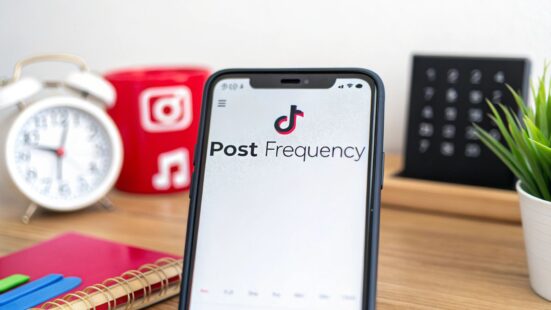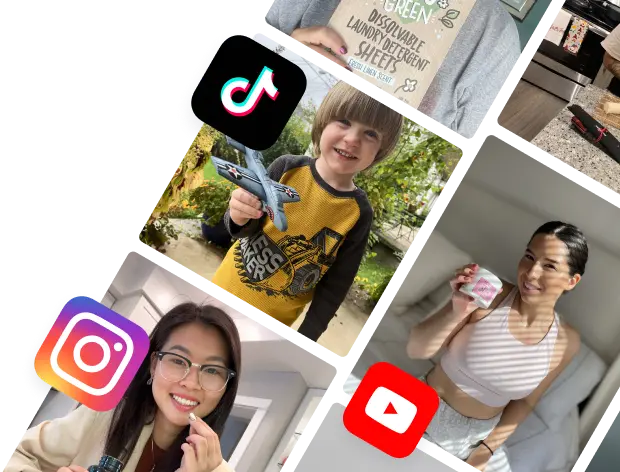 7 Influencer Marketing Examples to Boost Your 2025 Strategy
7 Influencer Marketing Examples to Boost Your 2025 Strategy
Figuring out how often to post on TikTok feels like a constant tug-of-war between quality and quantity. There's no secret number that works for everyone, but I've found a solid starting point for most brands is posting 3-5 high-quality videos per week.
If you have the team and the resources to really go for it, a more aggressive push of 1-2 times daily can kickstart rapid growth, but it's not for the faint of heart.
Table of Contents
The TikTok Posting Frequency Debate
The conversation around how often you should post on TikTok can get pretty heated. You'll find experts who swear by flooding the For You Page with several posts a day. Then you have others who preach a more deliberate, quality-over-everything strategy.
The real answer? Your perfect schedule comes down to your specific goals, how much content your audience actually wants to see, and—most importantly—how many genuinely good videos you can create without burning out your team.
This is where your analytics become your best friend. They show you exactly how consistent you're being, which is a huge factor for the algorithm.

The big takeaway here is that steady, high-quality posts—which you can track in your analytics—will always beat a chaotic, high-volume approach that just throws content at the wall.
Finding Your Starting Rhythm
Instead of just pulling a number out of thin air, think about these common posting frequencies as different game plans. Each one has a purpose and comes with its own pros and cons. To make it easier to see how they stack up, I've put them into a quick comparison table.
TikTok Posting Frequency Models at a Glance
| Posting Model | Frequency | Best For | Potential Outcome |
|---|---|---|---|
| Maintenance Mode | 1-3 times/week | Established brands with a loyal community. | Nurtures your existing audience and maintains your presence. |
| Steady Growth | 3-5 times/week | Most businesses looking for consistent growth. | Keeps you relevant and attracts new followers without sacrificing quality. |
| Aggressive Growth | 1-2 times/day | New accounts or brands in very competitive markets. | Maximizes your chances of hitting the FYP and growing fast. |
This table gives you a clear starting point. Most brands will find their sweet spot in the "Steady Growth" model, as it balances visibility with sustainability. It gives the algorithm enough fresh content to work with while giving your team enough breathing room to stay creative.
Recent data backs this up, suggesting that for many creators, posting between 1 to 4 times per week can actually deliver better results than daily posting, if the content is top-notch. Sure, posting more might give a new account a quick boost, but long-term success on TikTok is all about sustainability.
Your perfect posting frequency is the one that allows you to consistently create the best possible content for your audience without leading to creative burnout. It's a marathon, not a sprint.
Broader Trends Influencing Your Schedule
To really nail your timing, it helps to zoom out and look at the bigger picture. Understanding broader social media marketing trends gives you context for what’s happening across all platforms.
These shifts in user behavior and platform features shape what audiences expect to see. The goal isn't just to post often; it's to post smart, hitting the right notes with both your followers and the ever-changing TikTok algorithm.
Decoding What the TikTok Algorithm Rewards

Before you can figure out how often to post on TikTok, you need to get inside the head of its algorithm. Trust me, it’s not just about flooding the feed with content. It’s about understanding what the platform actually values and then giving it exactly that.
At its core, the TikTok algorithm is a sophisticated recommendation engine. Its only job is to keep people glued to the app by serving them videos they’ll actually want to watch. It does this by obsessively tracking how users interact with your content.
So, your posting frequency isn't just a number—it’s a strategy designed to consistently feed the algorithm positive engagement signals.
The Key Signals That Matter Most
The algorithm is always on the lookout for content that grabs and holds a viewer's attention. It measures this through a handful of key interactions, and your posting schedule has a direct line to every single one of them.
Here's how it works: a great video posted at the perfect time gets a rush of early engagement. This tells the algorithm, "Hey, people like this one!" and it pushes it out to more feeds. These are the signals that really move the needle:
- Video Completion Rate: This is arguably the big one. When someone watches your video from start to finish, it’s a massive vote of confidence.
- Watch Time: Just as important is the total time people spend on your video. The longer they stick around, the more interested the algorithm assumes they are.
- Shares: A share is the ultimate endorsement. When someone sends your video to a friend or posts it on another platform, TikTok sees it as top-tier content.
- Comments: A lively comment section signals that your video is sparking real conversation and building a community.
Posting consistently gives the algorithm more chances to learn about your account and, more importantly, figure out who your audience is. Think of each video as a data point that helps it get smarter about who to show your stuff to next.
Why Content Velocity Is a Game-Changer
Beyond these individual metrics, the algorithm is watching something else very closely: content velocity. In simple terms, this is how fast your video starts picking up steam—views, likes, shares, and comments—right after you post it.
A video that gets a sudden burst of love shortly after going live is far more likely to get the golden ticket to the For You Page (FYP). This is where your posting schedule becomes a powerful, strategic weapon.
By posting when your audience is most active, you dramatically increase your odds of getting that high initial velocity. This early momentum can be the difference between a video that fizzles out with a few hundred views and one that goes viral.
Your schedule is what sets this all in motion. If you post when your followers are asleep, your video gets a sluggish start, signaling to the algorithm that it might be a dud. But if you post during peak hours? You're giving your content the best possible launchpad. That’s the real secret behind a strategic posting schedule—it’s about giving every single video its best chance to shine from the second you hit "post."
Using Your Analytics to Find Your Sweet Spot
Forget guessing. It's time to start using data.
While general advice on posting frequency can give you a decent starting point, the most powerful insights on how often to post on TikTok are waiting right inside your own account. Your analytics are a direct line to your audience, telling you exactly when they’re most likely to see and engage with your content.
Generic advice is just that—generic. I once worked with a creator in the crafting niche who was completely frustrated with her low engagement. All the "best practice" guides told her to post in the evening. But a quick dive into her analytics revealed a totally different story. Her audience, mostly stay-at-home parents and retirees, was most active between 10 AM and 2 PM.
She shifted her schedule, and boom—her views and comments skyrocketed. That's the power of listening to your own data over the crowd.
Navigating Your Follower Analytics
Your first stop should be the 'Followers' tab within your TikTok Analytics. This is where TikTok hands you a clear, visual breakdown of your audience's activity. No more guesswork; it's a heatmap of your prime engagement windows.
You’ll see the specific days and hours your followers were most active over the past week.
This chart shows follower activity by the hour, helping you zero in on the best times to get your videos out there.

The taller bars point to the peak hours when the largest chunk of your audience is scrolling. Use these peak times as the foundation for your new, data-backed posting schedule.
Now, while your analytics provide a solid base, it's smart to layer in official guidance from TikTok itself. For 2025, the platform suggests creators post between 1 to 4 times daily to maximize their reach. This makes sense; more content keeps users on the app, which is what TikTok wants.
Their guidance also notes that engagement tends to peak from late afternoon into the evening. They recommend fewer posts on weekdays and ramping up to four posts on weekends. You can find more details on these recommendations over at RecurPost.com.
Running a Two-Week Test
Once you’ve identified your peak times, it's time to put them to the test. A simple two-week experiment is all you really need to find your frequency sweet spot.
Here’s a simple framework:
- Week 1: Post once a day, aiming for the absolute peak hour your analytics showed you. For example, if your peak is 7 PM, post at 7 PM every single day.
- Week 2: Now, dial up the frequency. Post twice a day—once at your primary peak time (e.g., 7 PM) and once at a secondary peak (e.g., 2 PM).
Throughout this test, keep a close eye on your video-level analytics. You'll want to track key metrics like views in the first three hours, the video completion rate, and how many new followers each post brings in.
Key Takeaway: The goal here isn't just finding the best time. It's about finding the best combination of time and frequency that drives the highest engagement without burning out your audience or your creative team.
After the two weeks are up, compare the results. Did posting twice a day lead to more overall views and engagement, or did it just dilute your impact? Let the numbers guide you toward building a schedule that truly works for you and your brand.
The Quality vs. Quantity Balancing Act
Every TikTok creator feels it: that constant pressure to post, post, post. But at the same time, you know your content has to actually be good. Figuring out your posting rhythm isn't about pulling a number out of a hat. It's about finding that sweet spot where you can create great stuff without burning out.
Chasing daily posts no matter what is a classic trap. You end up scrambling for ideas, which leads to burnout and a feed full of low-effort videos that just don't land. The algorithm rewards engagement, not just your ability to show up. A single, awesome video that gets tons of watch time and shares is worth way more than five rushed clips people immediately swipe past.
A Tale of Two Creators
Let's look at how this plays out in the real world.
Creator A: The Daily Grinder. This person is committed to posting every single day. They’re constantly scrambling, grabbing the first trending audio they hear, and rushing through filming. A few videos might get some traction, but most fall flat. Their growth stalls because the quality just isn't there to keep people interested.
Creator B: The Strategic Producer. This creator posts three or four times a week. Every video is well-thought-out, nicely edited, and speaks directly to what their audience loves. Because they give themselves more breathing room, their content is polished and makes a real impact. The result? Consistently higher engagement and steady, solid growth.
Creator B gets it. The "For You" page is crowded and competitive. You win by bringing value, not just by adding to the noise.
Finding Your Sustainable Pace
So how do you get off the content treadmill? You need a system. Instead of being in a constant state of reaction, you can get ahead of the game and manage your creation process to keep both quality and consistency high.
A game-changer for many is content batching. This just means blocking off a chunk of time—maybe a few hours on a Sunday—to plan, shoot, and edit multiple videos at once. You can knock out a whole week's worth of TikToks in one go, leaving you free to just hit "post" on schedule.
Another pro move is to set up content pillars. These are the three to five core themes or topics your account is all about. Having these pillars makes brainstorming a breeze and keeps your content focused, which is exactly what your niche audience is looking for.
The real goal here is to land on a posting schedule that energizes you, not drains you. Your best work flows from a place of creativity and smart planning, not from panicking to hit some random daily quota.
While a regular schedule is important, never let it come at the cost of your content's quality. Top-tier TikToks almost always have great visuals and clean audio, which often includes smart use of essential sound effects for video editing to make them pop.
The data backs this up. Recent stats show that accounts posting 1 to 4 times a day see much higher engagement than those who post randomly. This makes sense when you consider users spend an average of 95 minutes a day on the app. TikTok's own business guides even state that a consistent schedule can lead to a fourfold increase in engagement. You can dig into more of these TikTok posting frequency findings at SociallyIn.
What this data really tells us is that while posting often gives you more shots on goal, it only works if the content you're posting is good enough to grab attention in the first place.
Building a Sustainable TikTok Content Calendar
A solid strategy for how often to post on TikTok is one thing, but actually turning that into a manageable, real-world plan is where most people get stuck. It’s a classic case of knowing what to do, but not knowing how to do it consistently.
The secret isn't just about picking a posting frequency; it's about building a sustainable system that makes showing up feel effortless, not like a chore. This is where a content calendar becomes your absolute best friend. It moves you from random acts of content to a structured, intentional approach.
A great way to start is by thinking in monthly themes. For instance, if you run a fitness brand, one month could be "Foundational Strength." From there, you can break it down into weekly sub-topics like "Core Stability" or "Lower Body Basics." This bird's-eye view makes brainstorming specific video ideas a whole lot easier.
A crucial piece of a sustainable TikTok strategy is having a robust time management calendar to map out your schedule. This lets you block out dedicated time for every part of the process—from scripting and filming to editing and posting.
Structuring Your Content Week
With your themes in place, you can start mapping out a weekly schedule. The goal here is to balance different types of videos to keep your audience hooked and prevent your feed from feeling repetitive. A varied approach is what keeps people coming back for more.
Here’s a simple way you could structure a week to maintain a healthy mix:
- Educational Tips: Kick off the week by sharing a quick "how-to" or a valuable piece of advice related to your niche. This is how you build authority and trust.
- Trending Audio/Challenge: Always have a spot for a trending sound. This is your ticket to wider reach and landing on the coveted For You Page.
- Behind-the-Scenes (BTS): Give your audience a peek behind the curtain. Show your process, your workspace, or your team. This stuff humanizes your brand and builds a much stronger connection.
- Product Showcase: Don't be afraid to promote, but do it subtly. Show your product or service in action, solving a real problem for your audience.
This mix ensures you're not just selling all the time. You’re also entertaining, educating, and building a genuine community.
Pro Tip: Your calendar is a guide, not a prison. I always recommend leaving one or two empty slots in your weekly plan. This "flex space" is absolutely critical for jumping on those spontaneous, fast-moving trends without throwing your entire schedule into chaos.
Sample Weekly TikTok Content Calendar
To make this super practical, here’s a peek at what a week could look like. A simple table like this can help you organize your content pillars, nail down specific ideas, and track everything from concept to the moment you hit "post."
| Day | Time | Content Pillar | Video Idea/Concept | Status (Planned, Filmed, Posted) |
|---|---|---|---|---|
| Mon | 7 PM | Educational | "3 common mistakes to avoid when…" | Filmed |
| Wed | 8 PM | Trending Audio | Using the latest viral sound with a niche twist | Planned |
| Fri | 2 PM | Behind-the-Scenes | A quick tour of how a product is made | Posted |
| Sun | 6 PM | Q&A / Community | Answering a top question from comments | Filmed |
This kind of repeatable process is what truly unlocks consistency on TikTok. It transforms your strategy from an abstract goal into a concrete, day-by-day action plan, making it so much easier to hit your posting frequency targets.
Your Burning TikTok Posting Questions, Answered
Even with the best-laid plans, you're going to hit situations that make you question everything about your posting schedule. Specific problems crop up that you just don't find answers for in a general best-practices guide. This is your cheat sheet for those moments.
Think of this as your go-to reference when you're staring at your phone thinking, "Okay, what do I do now?"
Should I Delete and Repost a Flopping TikTok?
We've all been there. You post a video you're proud of, and… crickets. It’s so tempting to just nuke it from your profile and pretend it never happened, but my advice is: don't do it.
Deleting videos can actually work against you. The algorithm is always watching, and it values consistency. A pattern of deleting underperforming content might signal instability, potentially hurting your account's standing over time.
Instead of hitting delete, just set the video to 'private'. It vanishes from your public feed, but you haven't technically removed it. More importantly, this flop is now a valuable piece of intel. Dig into its analytics. What went wrong? Was the hook weak? Did the audio choice miss the mark? Was it the time you posted? Learning from your flops is just as critical as celebrating your hits.
How Long Should I Wait Between Posts on the Same Day?
If you're posting multiple times a day, you have to give each video its own space to perform. Dropping two or three videos back-to-back is a surefire way to cannibalize your own views. Your second post will end up fighting with your first for that initial push on the For You Page.
My rule of thumb? Wait at least three to four hours between posts. This gives the algorithm enough time to serve your first video to an initial audience, gather some data, and decide what to do with it. Spacing things out gives every piece of content a fair shot.
Is It Better to Post a Draft Now or Wait?
Ah, the classic creator's dilemma. The answer almost always depends on what kind of video you're sitting on. It's a constant balancing act between being timely and being strategic.
Here’s how I decide:
For time-sensitive content: Is your video built around a viral sound that's peaking right now? Is it a take on a news story or a challenge that's blowing up? Post it immediately. The lifespan of trend-based content is brutally short. Waiting for your "perfect" posting time could mean missing the boat entirely.
For evergreen content: If your video offers timeless advice, a funny skit, or anything that will be just as relevant next week as it is today, wait for your peak time. Check your analytics and drop it when your audience is most active. That initial wave of engagement is a huge signal to the algorithm to keep showing it to more people.
Getting a feel for this balance between "now vs. later" is one of those skills you'll sharpen with experience, and it's key to mastering your TikTok frequency.
Ready to scale your content without all the guesswork? JoinBrands is your direct line to over 250,000 creators, including TikTok Shop Affiliates who can produce authentic user-generated content that actually drives sales. You can manage your entire workflow, from creating a campaign to activating Spark Ads, all in one place. Find your perfect creator on JoinBrands today!








